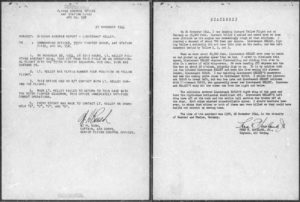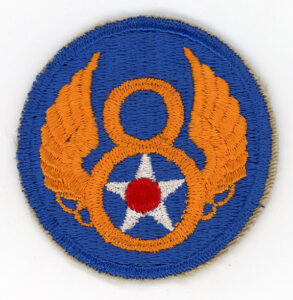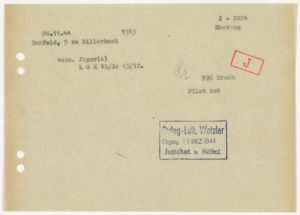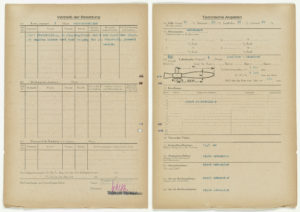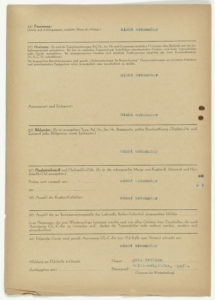The pilot who was lost that comes to mind…it was a shock, in a way…was this fellow Kelley, who was in the next bed to mine in the sleeping quarters. He had only been there three or four days. He was the one who was in the mid-air collision at Hanover, with another fellow named Barab from further down in the bunk. It was just a shock, because he came, and he was gone. A nice fellow. A happy-go-lucky fellow. His presence was just so ephemeral. That’s what struck me about it.
__________
The first aerial victory I was involved in was on a very mixed up day. That was over Hanover on November 26, 1944. I wasn’t with Moroney that day, I was flying with Fred Haviland.
There was a mid-air accident that day. Barney Barab and Bill Kelley flew into each other. They went right into each other directly, apparently, and I saw it an instant later. It was as if they both had turned to confetti, and it was all coming down. Red and silver confetti. Red and silver confetti. Just fell from the sky slowly, like small bits of paper. I mean there were pieces too, but it I remember “confetti”. The central mass was confetti!
…William S. Lyons, December, 1990
____________________
Sometimes, it helps to look back.
Case in point? “Revenge of the Tiger“, my post about the experiences of 1 Lt. William S. Lyons, who served as a fighter pilot in the 357th Fighter Squadron of the 355th Fighter Group during the Second World War. Given that “Revenge of the Tiger” has thus far received – and continues to receive?! – more “hits” than most other posts at TheyWereSoldiers, I thought it worthwhile to review the post, to see what new and untapped information might emerge from Bill’s story.
And so, yes … I found something.
The post includes several audio excerpts of an interview I conducted with Bill, one of which pertains to Bill’s memory of two fellow pilots who were lost in a mid-air-collision during the 355th Fighter Group’s escort mission on November 26, 1944: 1 Lt. Bernard R.J. Barab and 2 Lt. Charles W. Kelley.
Bill’s account can be found between 25:45 and 26:35 in the audio clip below. (This audio file is certainly still present in the original blog post, but I’m repeating it “here” in this new post, to save you the effort of searching for it.)
So. Here are two images from the Missing Air Crew Report for Lt. Barab, one page of which comprises a detailed, vivid report by Captain Fred R. Haviland, Jr. about the pilots’ collision.
Here’s a transcript of Fred Haviland’s account…
On 26 November 1944, I was leading Custard Yellow Flight out of Germany at 25,000 feet. Custard Yellow 2 called and asked that we lose some altitude as his engine was exceedingly rough at that altitude. I started a descent of about 700 feet per minute. Lieutenant KELLEY, flying Yellow 4 evidently did not hear this plan on the radio, and was left somewhat behind by Yellow 1, 2, and 3.
When we were about 20,000 feet, Lieutenant KELLEY dove down to catch up and picked up greater speed than we had. In order to dissipate this speed, Lieutenant KELLEY started fish-tailing and sliding from side to side in a series of mild wing-overs. We were heading 275 degrees and the sun was at about 10 o’clock, slightly high to us. It is my opinion that the sun blinded Lieutenant KELLEY and kept him from seeing his element leader, Lieutenant BARAB. I was watching Lieutenant KELLEY’S maneuvers and saw him coming quite close to Lieutenant BARAB. I yelled for Lieutenant BARAB to break left, but he was too late and Lieutenant KELLEY collided with Lieutenant BARAB, who apparently never saw Lieutenant KELLEY. Lieutenant KELLEY’S ship hit the other one from right and below.
The collision severed Lieutenant BARAB’S right wing at the guns and tore the right-hand horizontal stabilizer off. Lieutenant KELLEY’S left wing came off at the root and the entire tail section was broken off at the star. Both ships started uncontrollable spins. I should hesitate however, to state that either or both of these men were killed as they could have bailed out without my seeing them.
The time of this incident was 1330, 26 November 1944, in the vicinity of Munster and Rheine, Germany.
FRED R. HAVILAND, JR.,
Captain, Air Corps.
…and here’s a scan from Bill’s flight log, covering missions from November 9 through November 29. Note Bill’s comment about the November 26 mission:
FIRST DOG-FIGHT! SHOT DOWN ONE ME-109!! – ROUGH ENGINE ON WAY OUT
MID-AIR COLLISION BY BARAB & KELLY, ESCORT TO HANNOVER.
I learned from Bill that neither Barab nor Kelley survived, this information being quickly corroborated (and now readily available) from numerous sources, among these FindAGrave, the ABMC database, and, LittleFriends.
Biographical information about these pilots follows below…
1 Lt. Bernard R.J. Barab, 0-796643, Air Medal, 1 Oak Leaf Cluster, Purple Heart
Mr. and Mrs. Samuel and Mary (Curran) Barab (parents), Thelma and Eileen (sisters), 2 South Bartram Ave. / 927 Atlantic Ave. / 127 Ocean Ave., Atlantic City, N.J.
Mr. Richard L. Barab (cousin)
Ardennes American Cemetery, Neupre, Belgium – Plot C, Row 6, Grave 52
Bernard Barab’s name appeared in a Casualty List issued by the War Department on October 31, 1945. The New York Times published the list on November 1, limiting the names to servicemen from New York, New Jersey, and Connecticut. Barab’s name appears under “New Jersey – European Area”.
2 Lt. Charles W. Kelley, 0-826462 (presumably received Purple Heart; other awards unknown)
Born August 2, 1919
Probably from Hyattsville, Md.
Mrs. Helen Hawk (daughter) (Information from biographical profile at Registry of National WW II Memorial)
Mount Bethel United Methodist Church Cemetery, Crimora, Virginia

Barab and Kelley were among the seven 8th Air Force P-51 pilots lost that day, from whom number there emerged two survivors: Richard L. Barrett and Jack T. Gaston.
Specifics about all seven P-51 losses are listed below:
55th Fighter Group
38th Fighter Squadron
Coward, Huey Raye, 1 Lt. – Killed in Action
P-51D 44-15022, “CG * J”
MACR 10540 – Luftgaukommando Report J 2502
55th Fighter Group
338th Fighter Squadron
Barrett, Richard I., 1 Lt. – Survived (Prisoner of War at Stalag Luft III)
P-51D 44-14167 “CL * U” / “Purple Shaft”
MACR 10538 – Luftgaukommando Reports J 2496 and KU 3371
339th Fighter Group
504th Fighter Squadron
Van Cleave, Ely Neal, 1 Lt. – Killed in Action
P-51D 44-13938 “5Q * S”
MACR 10545 – Luftgaukommando Report J 2504
339th Fighter Group
505th Fighter Squadron
Stiles, Bert, 1 Lt. – Killed in Action (see also Wikipedia)
P-51D 44-14113 “6N * X” / “Tar Heel!”
MACR 10546 – Luftgaukommando Reports J 2503 and J 2505
355th Fighter Group
357th Fighter Squadron
Barab, Bernard R.J., 1 Lt. – Killed in action
P-51D 44-13574 “OS * A”
MACR 11079 – Luftgaukommando Report J 2624
355th Fighter Group
357th Fighter Squadron
Kelley, Charles W., 2 Lt. – Killed in action
P-51B 42-106910 “OS * M”
MACR 10886 – No Luftgaukommando Report
364th Fighter Group
383rd Fighter Squadron
Gaston, Jack T., 1 Lt. – Survived (Prisoner of War)
P-51D 44-13707 “N2 * E” / “Lady Dorothy IV”
MACR 10478 – Luftgaukommando Report J 2493
____________________
But… Was this the story’s end?
Something this incident just “seemed a little “off”. As intimated by Captain Haviland, given that the collision occurred at about 20,000 feet, further observation was impossible, and he suggested, “I should hesitate however, to state that either or both of these men were killed as they could have bailed out without my seeing them.”
Could either or both of these men have escaped their falling aircraft?
Perhaps more could be found in the Luftgaukommando Reports, which are incorporated within National Archives Records Group 242. The original documents themselves are now available in digital format via NARA, while there’s also a chronological list of Luftgaukommando Reports, but I don’t know if that’s yet been digitized. Using these two resources, I was able to identify relevant Luftguakommando Reports, and correlate these to specific planes and pilots, as listed above.
But. The Luftgaukommando Reports for Barab and Kelley (were there any?) presented a quandary: Neither the mens’ names nor the serial numbers of their P-51s appear in the chronological list of Luftgaukommando Reports, and, translations of any relevant reports are not included within MACRs 10886 and 11079. Still, with a bit of persistence (actually, a whole lot of persistence) I was able to locate the Luftgaukommando Report which I am certain pertains to Bernard Barab and P-51D 44-13574: OS * A: It’s report J 2624.
Though Lt. Barab’s name is nowhere present in the document – he’s simply referred to as “1 unbekannter Toter” – every other aspect of the report is consistent with the loss of his plane. Specifically, this comprises the date, time, number of airmen, circumstance of the aircraft’s loss (the “key” being a mid-air collision), and the observation that the aircraft possessed four Hamilton Standard propellers. You can view the document below, along with translations of some parts of the text.
__________
__________
__________

Art der Bodenberührung:
(Aufschlagbrand, Explosion in der Luft, Notlandung usw.)
Explosion beim Aufschlag
Bruch in Prozenten:
99%
Art der Erbeutung:
(Flak, Tagjager, Nachtjager, ohne erkennbare Kampfeinwirkung)
Zusammenstoss mit anderem Feindflugzeug
Sind Einschüsse erkennbar und welcher Art:
Nicht erkennbar
Wer ist Zeuge für die Art der Erbeutung:
Bauer Rockel
_ _ _ _ _
Type of ground contact:
(Impact fire, air explosion, forced landing, etc.)
Explosion on impact
Fracture / breakage [destruction?] in percent:
99%
Type of capture:
(Flak, day fighter, night fighter, without recognizable combat influence)
Collision with another enemy aircraft
Are bullets recognizable and of what type:
Not visible
Who is the witness for this type of capture:
Farmer Rockel
__________
(Identification of casualty)
Tote, insgesamt 1 Mann wahrscheinlich
Nicht feststellbar, da Flugzeugführer unter der Maschine liegt.
(Identification of casualty)
Dead, probably a total of 1 man
[Identification] not detectable because the pilot is lying under the machine.
__________
__________
Nachmeldung ueber den bruch einer feindmaschine am 26.11 tagesangriff verkehrsanlagen raum Hamm – Bielefeld – Osnabrueck.
Late report about the breakage [destruction] of an enemy machine on the November 26th, daytime attack on traffic [rail? – transportation?] systems in the Hamm – Bielefeld – Osnabrueck area.
______________________________
For an unknown reason, reference to the loss of Lt. Barab’s P-51 was made in Luftgaukommando Report KU 3351, which covers the loss of Low Pressure Lulu, B-17G 43-37646 of the 833rd Bomb Squadron, 486th Bomb Group, on November 21, 1944. Eight of the bomber’s nine crew members survived, the sole fatality having been the bomber’s pilot, 2 Lt. Howard I. Glashoff, Jr. Note that KU 3351 incorporates reference to Reports J 2465 (1 Lt. Leland M. Stoudt), J 2466 (1 Lt. Boyd O. Jackson), and a KE Report for a Halifax lost on December 6 (KE 10054 – aircraft NP695 of No. 432 Squadron RCAF, piloted by F/O G.H. Speirs).
The location is listed as “4 km. nördl. Darfeld Bauerschaft Rockel, i/Westf.”, [4 km north of Darfeld…] while the status of the pilot – thus explaining Lt. Barab’s years-long postwar MIA status – is listed as “nicht feststellbar, da Flugzeugfuhrer unter dem Flugzeug ca. 5 m im Sumpf liegt.” [“Cannot be determined because the pilot is about 5 meters under the swamp in the aircraft.”]
So, based on report J 2624, and the references in KU 3351, this map shows the probable location where Lt. Barab’s Mustang fell to earth.
____________________
According to a newspaper article published in Atlantic City in the late 1940s, Lt. Barab was only and eventually identified by the end of that decade, I think through the serial number of his parachute. If he even survived the mid-air collision to begin with, he was – sadly – unable to escape from OS * A as it fell four miles through the late November sky.
But, what of Lt. Kelley?
Astonishingly, he survived the collision.
Remarkably, he was able to successfully escape from the broken wreck of his Mustang, and, parachute to earth uninjured.
Tragically, he did not survive to be taken to a prisoner of war camp; to be liberated in April or May of 1945; to eventually return to the United States; to be reunited with his wife and daughter. For, as documented in detail at Aircrew Remembered – specifically at the blog appropriately entitled post “Archive Report: US Forces – 1941-1945 – 26.11.1944 357th Fighter Squadron P-51B Mustang 42-106910, 2nd Lt. Charles W. Kelley” – he was murdered on November 27, 1944, a day after he fell to earth.
Since the account at Aircrew Remembered represents original work based on contributions from a number of references and researchers, and is also right-click / copy-protected (!), I can’t and won’t “copy & paste” the text “here”, at this post. For full details, refer to the link above. However, here’s a summary of the account…
From early March through early May of 1947, six German nationals were tried before a Military Court at Osnabrück on ten separate charges. Four of these individuals were accused of aiding former SA Standartenführer Fritz Bollenrath (who committed suicide on December 5, 1945, shortly after being arrested) in the killing of “Kelly” (Kelley). The four were former Luftwaffe Stabsfeldwebel Heinz Stellpflug, former Luftwaffe Feldwebel and clerk August Hackethal, former Luftwaffe Major Karl Henkelhausen, and, former Luftwaffe Major Walter Klöpzig.
The specific events between Lt. Kelley’s downing and his murder will probably never be known. But, according to the Aircrew Remembered account, on November 27, Bollenrath arrived by auto at the Commandant’s Office (at the Rheine airfield, in Westphalia province?) with an Allied airman (presumably Kelley), upon which he stated that the prisoner must be shot. After a drink of schnapps, the trio of Bollenrath, Hackethal, and Stellpflug then drove to a nearby wood (the Muniwald), and stopped their vehicle, which Kelley was made to exit. Stellpflug, under Bollenrath’s orders, fired one shot at Kelley (which apparently missed) and then Bollenrath fired a further two shots, both of which struck and apparently killed the defenseless prisoner. However, despite Bollenrath’s orders, Hackethal refused to shoot the pilot.
Stellpflug, found guilty for participating in the the murder of RAF Wireless Operator / Air Gunner Sgt. Gilbert J. Harris (one of the two initial survivors of Lancaster I LM213 of No. 12 Squadron, shot down January 16, 1945), was executed on September 5, 1947. Klöpzig was eventually released for lack of evidence, while Schmitt and Henkelhausen were found not guilty.
Though I cannot state so definitively (not having access to his Individual Deceased Personnel File), it seems that no Luftgaukommando Report exists pertaining to Lt. Kelley and his P-51B.
Or…? Perhaps the document was indeed created, and still exists, but like Report J 2624 for Lt. Barab – does not actually list the pilot’s name, which would make the Report’s identification, whether via digital or physical searches, a lengthy and challenging process.
Or…? Perhaps, given Lt. Kelley’s murder, the document was either destroyed, or, never compiled in the first place.
And, although Fritz Bollenrath escaped the justice of men, there is another kind of Justice, one that is entirely inescapable.
References
Aircrew Remembered
Vitz Archive: Allied Victims of Axis Murders
Archive Report: Axis Forces 1914-1918 1935-1945 – Standartenführer Fritz Bollenrath
Chorley, W.R., Royal Air Force Bomber Command Losses of the Second World War – 1944, Midland Publishing, Hinckley, England, 1997

